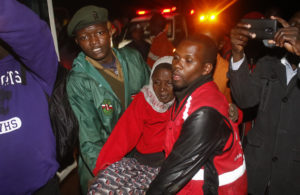Dam bursts in Kenya after weeks of heavy rain, sweeping away homes and killing dozens
At least 44 people were killed when the Patel dam burst in the Nakuru county of Kenya on Wednesday evening. Authorities say 40 others were injured and dozens were missing, after the wave of water, which was over a five feet high and 1,500 feet wide, obliterated everything in its surrounding area.

“It was a sea of water. My neighbour was killed when the water smashed through the wall of his house. He was blind so he could not run. They found his body in the morning,” Veronica Wanjiku Ngigi, a resident of one of the communities devastated by the break told Reuters. “My other neighbors also died. All our houses have been ruined.”
The dam, which was reported to have cracks and leaks prior to the collapse, was located just over 100 miles north of Nairobi on a large privately-owned commercial farm in a rural agricultural area. According to residents of the surrounding communities, two other dams on the property are also full and could burst in the future.
After receiving reports that claimed that the dam had not passed government engineering inspections, Kenya’s chief prosecutor opened an investigation into its compliance with code. The owner contends that the sole reason for the dam’s collapse is the torrential rain that the region has experienced this year.
The rains, which follow a drought in 2017 that left 2.6 million Kenyans in need of food aid, have caused the deaths of over 170 people in Kenya since March. Flooding has shut off communities from vital markets and disaster relief, and has displaced over 200,000 people. Additionally, flooding has expounded a cholera outbreak, which has killed 55 people since the beginning of 2018.
“This is a double tragedy for many communities,” said the secretary general of the Kenya Red Cross Society, Abbas Gullet. “These people are strong, and they have already overcome so much adversity. But there is only so much a person can take, and I’m worried that these floods will push some people beyond the brink.”
The rains have caused deadly mudslides and widespread flooding across the East African region. Thousands of hectares of farmland has been inundated.
In Somalia, the river banks of its two largest rivers burst far earlier than usual. Since the beginning of April, over 700,000 people have been affected by the floods, and 228,000 have been displaced. The high number of internally displaced people prior to the floods has also proved to be the group most vulnerable to its impacts, as many of their camps are along river beds and in low-lying areas. The UN Food and Agriculture Organization reports that the floods are “some of the worst the region has ever seen” and the Somali president has appealed to the international community for ongoing aid.
[Featured image: People gather in front of the broken banks of the Patel dam near Solai, in Kenya’s Rift Valley, Thursday, May 10, 2018. A dam burst its banks in Kenya’s Rift Valley, killing at least 41 people and forcing hundreds from their homes, officials said Thursday. At least 20 of the dead were children, police said. (AP Photo)]
Sources and further reading:
Kenya Patel dam burst: Dozens still missing in Solai – BBC News
“Sea of water” from Kenya dam burst kills at least 32 – Reuters
Burst dam at Kenyan rose farm lacked permits, police investigate – Reuters
Kenya dam bursts, killing at least 41 and sweeping away houses in ‘sea of water’ – Washington Post
Rwanda landslides: At least 18 killed after heavy downpour – Al Jazeera
Lethal flash floods hit east African countries already in dire need – The Guardian
